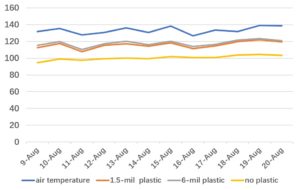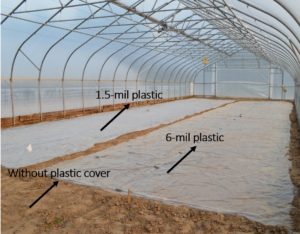Soil solarization can be used as a tool for soil disinfestation. It is accomplished by covering moist soil with transparent polyethylene film for 4 to 6 weeks in the summer. During this period, soils are heated to temperatures that are lethal to many soil pathogens, nematodes and weed seeds.
This summer we conducted a demonstration trial in one of the high tunnels at Southwest Purdue Ag Center. The high tunnel was divided into three parts that were covered with 6-mil plastic, 1.5-mil plastic, and no plastic. The 6-mil plastic is the old covering of the high tunnel, and the 1.5-mil plastic was purchased from a paint store. Air temperature and soil temperature at the depth of 12 inches were recorded. We saw little difference between temperatures of the soils covered with 6-mil plastic and 1.5-mil plastic, which indicated that the old coverings of high tunnels are as good as thin plastic for soil solarization.
The maximal daily temperatures in the top 12 inches of the soil under solarization are generally above 110ºF for 5 to 9 hours per day (Figure 1). In the areas without solarization (no plastic covering), maximal daily soil temperatures at the depth of 12 inches are around 100ºF. The duration of the highest temperature determines the lethal effects on soil pathogens. Temperatures above 110ºF for more than 10 hours normally have a lethal effect on most soil pathogens.

Figure 1. Air and soil temperatures (ºF) at a depth of 12 inches under the 1.5-mil plastic, 6-mil plastic, and no plastic.
The following pictures were taken during and after the soil solarization (Figures 2 and 3). It clearly showed that soil solarization suppressed the weeds in the high tunnel. In the next step, we are going to plant carrots in the tunnel, which will provide us with the opportunity to see a longer effect of soil solarization on weed control in the high tunnel.

